
Jamaican Provisioning Locations Menu: 1 2 3 <<First
Golden Age of Piracy Provisioning - Jamaica, Page 3
Jamaican Food Descriptions, Cont'd
Bread and Grains
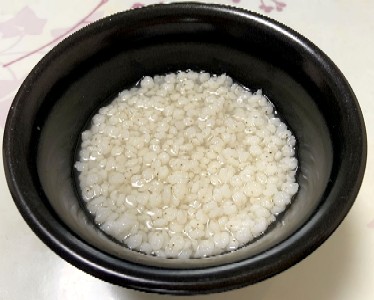
Photo: Wiki User Taro - Boiled Sorghum Wheat
There is some overlap between vegetables and grains in the period and near-period descriptions of Jamaican foods. Charles Leslie refers to Indian and Guinea corn (sorghum) as well as peas as grains.1 While sorghum is considered a grain, peas and corn have dual identities. Corn on the cob and peas in a pod are both considered vegetables, although individual corn kernels are considered grains and shelled peas are considered legumes like beans.2 Sloane notes that the peas and bean found on Jamaica were different than those grown in England without expanding on that point. "They are eaten when green, as ours of Europe, and when dry, boil'd, afford the Negro very good and strong Provision."3
Taylor notes that the islanders plant corn in January and June and it "grows to perfection and yeilds its seed in three months' time in seasonable weather, which standeth the planter in good steed in the maintainance of his Negroa slaves, horses, hogs and fowles, and is the principall food of ye Indians."4 Sloane says that "Indian Corn or Maiz, either tosted or boil'd, is fed on by the Slaves, especially the young Ears of it, before ripe, are rosted under the Coals and eaten; this is thought by them very delicious"5. Talking about Barbados, Richard Blome similarly recommends that "servants and Negroe-slaves" be fed "with Potatoes, Loblolly, made of beaten Maize mixt with water; Cassader-bread common in all the Indies, Bonavist, and such like food that the Plantation affordeth"6. The fact that Sloane says it tastes good suggests he tried it, although the consensus among these three authors is that corn was not generally eaten by the English.
Like Barbados, the difficulty in procuring bread and flour was noted by the various 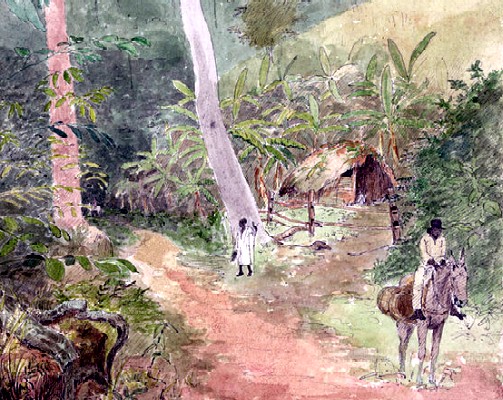
Artist: William Berryman - Plantain Walk in Jamaica, (1808-16) authors of this time. Hans Sloane gives a list of substitutes he found while living on Jamaica including sweet potatoes and yams, corn, plantains, sorghum (which he calls guinea corn), cassava root flour, and, to a lesser degree, rice. The first two have already been discussed. Sloan calls plantains one of the
most general support of Life in the Island. They are brought in from the Plantain-Walk, or place where these Trees are planted, a little green; they ripen and turn yellow in the House, when, or before they are eaten. They are usually rosted, after being first clear'd of their outward Skins, under the Coals. They are likewise boil'd in Oglio's or Pepper-Pots [types of stews], and prepar'd in to a Past[e] like Dumplins, and several other ways.7
Leslie lists plantains, yams and the cassava root flour as 'the common bread', mentioning that a plantain "when pulled green, and roasted, eats very deliciously."8
Sloane says sorghum is prepared and used the same way as rice, tasting just "as well, and is as nourishing."9 Rice he noted was too difficult to process for the price it would fetch and, as a result, wasn't grown by many of the planters.
Much is said of cassava root and the bread which is made from it. Taylor says that the root produces 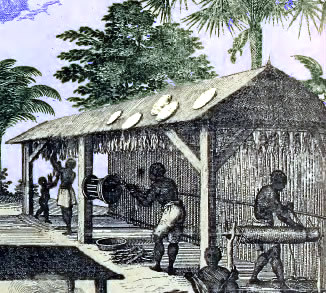
Cassava Wafers Drying on Roof of Shack While
Slaves Process
Tobacco, From Histoire generale des Antilles (1667)
"a verey white bread (eaten not only here by most of the inhabitants, but also in most other parts of America, by the Spaniards, English, Dutch, French and the native Indians"10. Taylor, Leslie and Sloane all explain how cassava root was processed and cooked to make bread, although their explanations add little to Richard Ligon's explanation which quoted in the section on breads and grains found on Barbados.11 Leslie, writing about his time on Jamaica around 1720, comments that cassava bread is "preferred by our Creoles to any other Bread whatsoever. They do not want Flour from New-England, and the Northern Colonies."12 Sloane explains that cassava bread "is eaten dry as ours, or dipt in water, on which it immediately swells, and has no very pleasant taste this way, though dry it has none at all. Dipt in sugar'd water this Bread is still more pleasant, and if it be a little tosted afterwards, it eats yet better."13 He adds, "It will keep a long time without Corruption, so that it is taken as Provision for the Sloops trading to the Spanish Main, &c. This Bread is worth about seven Shillings and six pence the hundred weight, sometimes double that, according to its scarcity."14 So, unlike many of the other things listed, this was one of the commodities which was explicitly provided to ships as provision.
1 Charles Leslie, A New History of Jamaica in thirteen Letters, 1741, p. 37, 2 Diana Wells, "Is Corn a Vegetable?", healthline.com & "Beans and peas are unique foods", choosemyplate.gov, gathered 3/22/20; 3 Hans Sloane, A Voyage to the Islands Madera, Barbados, Nieves, St Christophers and Jamaica, Vol. 1, 1707, p. xix; 4 John Taylor, Jamaica in 1687, David Buisseret ed, 2010, pp. 116 & 205; 5 Sloane, vol. 1, p. 150; 6 Richard Blome, A Description of the Island of Jamaica, 1672, p. 86; 7 Sloane, vol. 1, p. xix; 8 Charles Leslie, A New History of Jamaica in thirteen Letters, 1741, p. 23, 9 Sloane, vol. 1, p. xix; 10 Taylor, p. 217; 11 See Taylor, pp. 217-8, Leslie, pp. 23-4 & Sloane, vol. 1, p. xviii; 12 Leslie, pp. 24; 13,14 Sloane, vol. 1, p. xix;
Fish
Concerning fish, Sloane said "I know not, neither have I heard of any Place where there are greater Plenty of fresh Water and Sea Fishes, than in the Island and on the Coasts of Jamaica, which is a great Providence and Contrivance for the Support of the Inhabitants"1. However, he also points out that he lived six miles from the sea and, as a result, his knowledge was imperfect. Richard Blome likewise notes that the island has "very excellent Fish, and in such abundance that it contributes much to the feeding of the Inhabitants...but [in] such great Variety of those appropriated to the Indies, that it would be too tedious to Repeat the names of them, if they were known or Remembred."2 Fortunately, Taylor provides a fairy long list of fish he found while on Jamaica. These include:
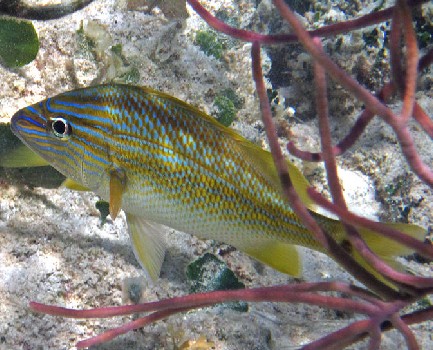
Photo: James St John - Haemulon plumieri - White Grunt, Bahamas
jewfish [Atlantic goliath grouper], parrat fish, dolphin, baracoda, grooper, albecole [possibly the black-finned tuna], booneta, Spanish-macrell, mullet, rock fish, cavalie, tarpum [tarpon], grunt [Haemulon plumieri], audwife [oldwife], garfish, stingaree [stingray], swordfish, sharck... conny fish [cow fish - acanthostracion], snapper, sea urchin, remora, flying fish, pillot, whitfish [white fish - harenguilias], stonebass, leather coats [jacks], smelts, elle, mudfish, crawfish, prawns, sea crab, land crab, cuncks [conches], wilkes [whelks], calphia, soldiers [soldier crabs], oyster and sea egg.3
Taylor's list contains both fresh and salt water fish and a variety of the creatures listed are technically not fish at all (several other entries were removed for this reason). Sailor Francis Rogers was at Jamaica in August and September of 1705 and he provided a list of fresh-water sea creatures found on the island including "snappers, snooks [and] flat fish [probably flounders]"4. He also listed several salt-water fish, many in common with those mentioned by Taylor, adding skipjacks and king mackerels noting that all of them were very good to eat. Charles Leslie notes that the Jamaican mullets are "exceeding palatable, and the Calipever [Labranche mullet] little inferior to the finest Salmon: They excel in Sweetness any that I know."5
Taylor also comments on the taste of many of the fish he mentions, although the gist of them is that the fish tasted good. His observations include 'sweet', 'good', 'greatful to ye pallat','well esteemed' or 'good nutriment'. Some of the fish about which he has good things to say include barracudas,
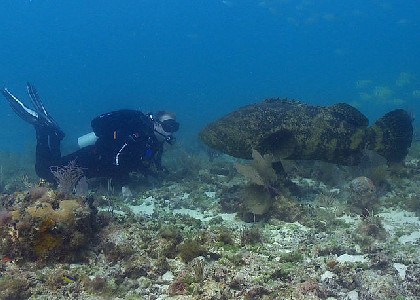
Photo: Brett Seymour - Atlantic Goliath Grouper and Diver, Tortugas National Park
jacks, groupers, mullets, bonetas, black-finned tunas, grunts, remora, stingrays and mackerels.6 Taylor also identifies snappers, white fish and stone bass as good fish for frying.7
Taylor calls the Atlantic goliath groupers "an exceding fatt and delicious fish, and in fine, one of the best fishes in America. ...Of this fish they make a great dish at Port Royall by cutting it into small peices and frieing it very dry in oyle, and then puting it up in a pickle flavour'd with spices, which is of excelent use and proffit to 'em for a regale [feast]."8 Buccaneer William Dampier said this fish, found around Jamaica and Curaçao could be purchased at Jamaica. Of the flavor, he commented, "It is very sweet Meat, and commonly fat."9
Both Sloane and Taylor suggest that mud fish are among the best tasting of all the fish found on Jamaica. Taylor says it is "an excellent sweet fatt and delitious fish, and in my opinion, next to the manatee, the best fish I ever eat of in any part of America."10 Even Sloane, who often stops after describing a fish says, "They are in all the fresh Water, Lakes and Rivers in the Island, and are accounted one of their most delicate Fish."11 What a mud fish is isn't entirely clear since the term is used refers to a lot of different fish which like to sit on the bottom. From Sloane's description, it may have been a Spinycheek sleeper (Eleotris pisonis).
1 Hans Sloane, A Voyage to the Islands Madera, Barbados, Nieves, St Christophers and Jamaica, vol. 2, 1707, p. 275; 2 Richard Blome, A Description of the Island of Jamaica, 1672, p. 23; 3 John Taylor, Jamaica in 1687, David Buisseret ed, 2010, p. 217; 4 Francis Rogers. Three Sea Journals of Stuart Times, Bruce S. Ingram, ed., 1936, p. 230; 5 Charles Leslie, A New History of Jamaica in thirteen Letters, 1741, p. 13; 6 Taylor, pp. 157-9 & 165-6; 7 Taylor, pp. 165-6; 8 Taylor, p. 155; 9 William Dampier, A New Voyage Round the World, 1699, p. 249; 10 Taylor, p. 168; 11 Sloane, vol. 2, p. 286
Turtle
One sea creature of great importance to the food supply on Jamaica
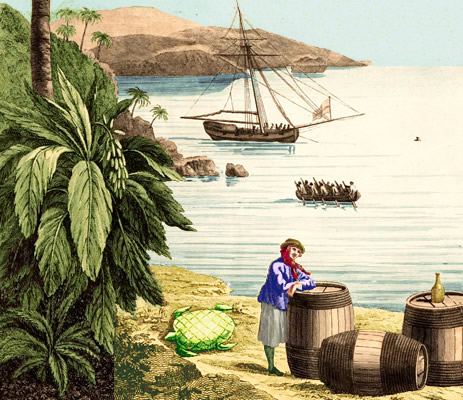
Artist: Thomas Jefferys - Turtle Taken, The West Indian Atlas (1783)
was the turtle. It was typically referred to in the period accounts as a fish. Navy captain Nathaniel Boteler comments on their importance to navy sailors in replacing their typical meats during the first half of the 17th century has already been mentioned. Richard Blome said, "The principal sort [of seafood on Jamaica] is the Tortoise, which they take plentifully on the Coast... it being reputed to be the wholsomest and best provision in all the Indies."1 Charles Leslie reported that "the Tortoise... is fine, and exquisitely pleasant."2 Taylor called it the "most delicat food, and in my oppinion the best of meat in the whole world. It lookes whiter than veale or mutton and eateth exceeding sweet and tender, much like (tho' much better than) a good fatt Europian capoon [capon - male chicken]"3.
Turtles were frequently used as food by sailing ships. A primary reason for this was that they could last for quite some time at sea without being salted. John Taylor explains that "they will live on board ten daies and will drinck watter out of a bucket like a hog and are brought in sloops to Jamaica. This is here counted the best of fish and is sold for two royalls a pound."4 Merchant sailor Nathaniel Uring said when he was at the Bay of Campeche in July of 1712 that "they’ll live a long Time without either eating or drinking. I have been assured that some have lived several Months without either; but ‘tis very common to keep ‘em several Weeks in the Hold of a Sloop, while they are going from the Place where they take them to Market at Jamaica"5.
As Uring indicates, sea turtles were often brought to Jamaica to be sold at the market there during the golden age of piracy.
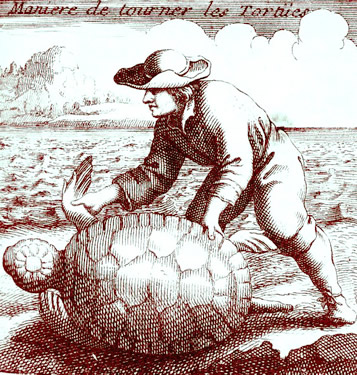
Flipping a Turtle. From Nouveau Voyage aux Isles de l'Amerique,
By Jean Baptiste Labat, p. 290 (1742)
The preferred types, such as green turtles, were not as common around Jamaica as they were around other Caribbean Islands. Physician Hans Sloane explained that green sea turtles "are brought in Sloops, as the Season is for breeding or feeding, from the Caymanes, or South Cayos [cays] of Cuba, in which forty Sloops... belonging to Port Royal, are always imployed. They are worth fifteen Shillings apiece"6. Writing about Grand Cayman when he was in the Caribbean in 1678, merchant sailor Edward Barlow noted that "the people of Jamaica come continually there to catch turtle or tortoise, which they take a-many of and carry to Port Royal, which they kill and sell by the pound for twopence and threepence per pound; and it is a thing that helps the island very much, and is very good victuals, and sometimes in the year they salt it and keep it salted a long time."7
Sloane explains that when the turtles arrived at Jamaica, they were "put into Pens, or Palisadoed places in the Harbour of Port 'Royal, whence they are taken and killed, as occasion requires. They are much better when brought in first, than after languishing in those Pens, for want of Food."8 Along these lines, Uring talks about the turtles they kept while near what is today Belize City. "We used to keep ours in a Pen, which was made thus; Having cut down a Number of thick strong Stakes, we drove them into the Ground in a Shoal part of the River in the form of a Square, leaving a Door on one side for the Conveniency of taking them out when we wanted them."9
Taylor identifies four types of turtles on Jamaica - the green turtle, the loggerhead (which he calls a lacquerhead), the hawksbill and the terrapin. He basically dismisses the loggerheads and hawksbills as being 'not esteemed'.10 Sloane likewise discounts the value of such turtles as food. "All sorts of Sea Tortle, except the green, are reckon'd fishy, and not good Food."11
Certain fresh water turtles are given a much better reputations. Taylor advises that land-based terrapins (most likely Jamaican sliders - Trachemys terrapen) are "fatt, gratefull to the pallat and of hollsom nutriment and a great restoritive in consumptions."12
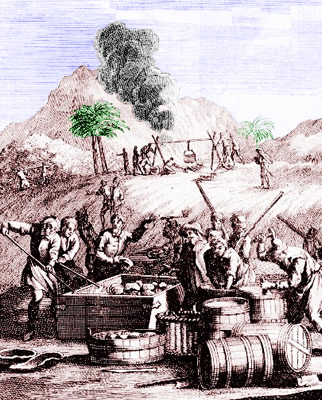
Artist: Peter van der Aa
Salting Turtle, From Versameling der Gedenk-Waardigste Zee en
Land-Reysen na Oost en West-Indiën, Vol, 12, p. 40 (1707)
Sloane says these turtles, "are counted more delicate Food than those of the Sea, although smaller. They are, as I have been told, on the main Continent of America, pen'd and fed with Patata-slips, &c. and drawn out as occasion requires either for victualling the Flota [fleet], or for the private expence of their Houses."13
The writers during this period have much to say about the green turtles.
The flesh of this creatur when boyl'd or roasted eats just like our English veal. They are very fatt and their fatt is of a sea-green colour and eateth as delitious as marrow. They cutt 'em out in fouer quarters, and the callapee [Taylor is confusing 'calipee' - the yellow substance found in the lower half of a turtle shell which he discusses below - with the plastron or bottom part of the turtle shell] or belly-peice, which rosted is most excelent food, and being baked fare excelleth a venison pastie. Now you must understand that altho the fatt of the quarters etc. of this creature is green yet the vela pinguinosae intestinorum or the fatt on the gutts is yallow as gould. These gutts are accounted some of the best in the tortoise and eateth delicat and tender. The flesh which grows on to the bakepeice [back piece] is sold with the callapatch [calipach - green substance found in the upper half of a turtle shell], of which they make fingrigo and sippets [Taylor's editor notes ''Sippet' is an archaic word for a small piece of toasted or fried bread'], a dish common at Jamaica.14
Merchant sailor Francis Rogers talks about cooking turtle without identifying the type of turtle, although his description is similar to Taylor's description of green turtles. Rogers said that they were "most commonly baked in the under shell, (with spice, dry herbs, and forced meat [a mixture of meat or vegetables chopped and seasoned],) which they call the calipee; the other dressed they call the calipach. The flesh looks and eats much like choice veal, but the fat is of a green colour, very luscious and sweet"
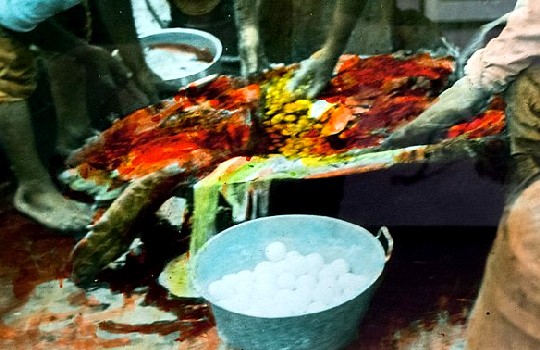
Harvesting Green Turtle Eggs and Meat in Senegal, During the Voyage of the Blossom in the 1920s
15. Sloane calls turtles "very good Victuals, and sustain a great many, especially of the poorer sort of the Island."16 Here again Sloane suggests that a food more easily procured than imported foods was not preferred by wealthy English planters. Sailors would have been considered 'the poorer sort', along with indentured servants and planters with small plots of land.
Turtle eggs were also well regarded. Francis Rogers says "their eggs are like a hen’s egg, without the shell; they’ll lay 200 or more, and are very good."17 Taylor agrees that they are like chicken eggs, "but round, and hath a thick soft white skine instead of a shell. They have both yolke and white as the egge of a fowle and eateth full as good when they are taken out of hir belly, but those which are not come to perfection but lookes yallow are the best eggs."18
1 Richard Blome, A Description of the Island of Jamaica, 1672, p. 24; 2 Charles Leslie, A New History of Jamaica in thirteen Letters, 1741, p. 24; 3 John Taylor, Jamaica in 1687, David Buisseret ed, 2010, p. 150; 4 John Taylor, Jamaica in 1687, David Buisseret ed, 2010, p. 217; 5 Nathaniel Uring, A history of the voyages and travels of Capt. Nathaniel Uring, 1928, p. 167-8; 6 Hans Sloane, A Voyage to the Islands Madera, Barbados, Nieves, St Christophers and Jamaica, Vol. 1, 1707, p. xvii; 7 Edward Barlow, Barlow’s Journal of his Life at Sea in King’s Ships, East and West Indiamen & Other Merchantman From 1659 to 1703, p. 315; 8 Sloane, p. xvii-xviii; 9 Uring, p. 168; 10 Taylor, p. 154; 11 Sloane, p. xviii; 12 Taylor, p. 155; 13 Sloane, p. xviii; 14 Taylor, p. 151-2; 15 Francis Rogers. Three Sea Journals of Stuart Times, Bruce S. Ingram, ed., 1936, p. 230; 16 Sloane, p. xvii; 17 Rogers, p. 230; 18 Taylor, p. 153
Terrestrial Animals
Several different terrestrial animals provided meat on Jamaica including cattle, pigs, sheep and goats. In addition, some unusual creatures were used as food such as rats, cats, dogs, and iguanas.
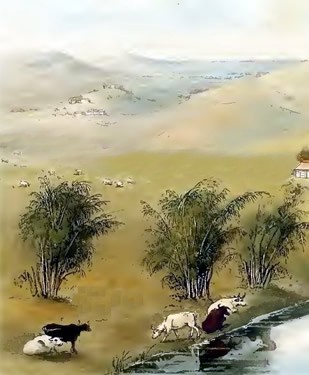
Artist: James Hakewill
Cattle on the Savannah, From A Picturesque Tour of the Island
of Jamaica (1825)
By the beginning of the golden age of piracy, some of the English plantations on Jamaica had been in operation for thirty years or more and had tamed cattle as part of their food supply. Richard Blome wrote about that English plantation-raised "Cowes [which] are very large, and so numerous, that although there hath been every Year so many Killed, yet their number seemeth not much to be lessoned."1 Commenting on his visit, physician Hans Sloane said "Cattle are penn'd every night [after spending the day on the savannah], or else they in a short time run wild. These Pens are made of Palisadoes, and are look'd after very carefully by the Planters."2
Sloane said that the beef at Jamaica was "very well tasted, and good, unless when Guinea Hen weed rises in the Savannas.... Then their whole Flesh tasts so much of it, that one cannot well eat it, at which time likewise it infects their Milk"3. He also said that the "Oxen who have been drawing in their Mills, and are well fed on Sugar-Cane-tops, are reckoned the best Meat, if not too much wrought. They are likewise fatted by Scotch Grass."4 Not everyone agreed. Taylor, who was on the island around the same time, said "their flesh is not soe fatt nor solid as our English beef... But for present spending it is indeferent [average]."5 Writing about 1720, Charles Leslie dourly commented, "Their Beef is tough and lean, scarce fit for any thing but Soups."6
Note that Sloane mentioned using the cows for milk. This suggests dairy products could have been made and available on Jamaica. However, Taylor explains "here they have noe dairies, nor doe they make any considerable
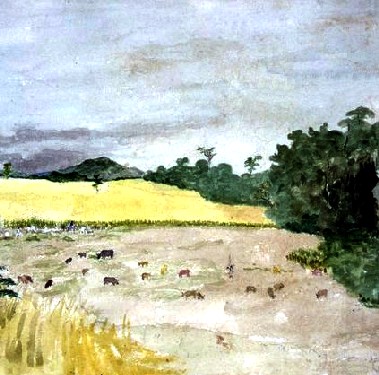
Artist: William Berryman
Cattle Feeding on Cane Stubble in Jamaica (1808)
profit from the milke, for there is neither cheese nor butter made but only att two or three great plantations in the whole island."7 He goes on to explain that even planters with six to seven hundred cows in their herd only milk six to ten of them, and that is used for making chocolate drinks, custards, tarts and the like.
In addition to plantation-raised cattle, the wild cattle roamed the woods of the island. Taylor explains that they were caught "by hunting, which if they soe caught in the mountains, they preserved by takeing out all the bones, and then drieing it in the sun after they had put a small quantity of salt thereon; this they called jerk't beef, or hog, soe that those which betook themselves to hunting got considerable profitt thereby."8 This highlights the problem of salting meat in the Caribbean. The manner used for preparing meat for sea voyages in England was problematic; Sloane blamed "the Temperature of the Climate and Air [for] hindering the salting, preserving, or drying Provisions"9. He describes the process of jerking pork in a manner similar to Taylor, adding that after the bones are removed, the flesh is 'gash'd' on the inside.10 Even fresh meat had to be cooked and eaten quickly. "Although there is here in the Savannas great plenty of Cattle, yet they cannot keep Beef past some few days, and that salted [jerked], otherwise in three or four hours 'tis ready to corrupt. Butchers always kill in the morning just before day, and by seven a Clock the Markets for Flesh-Meat are over."11
Photo: Susanne Bollinger - Pigs in Sty
Like cattle, there were two types of swine: domesticated and wild. Richard Blome (writing before the golden age of piracy) and Charles Leslie (writing after it) both mention that there are a large number of tame hogs on Jamaica.12 Domesticated swine raised on remote plantations were allowed to run free during the daytime according to Sloane. "The Swine come home every night in several hundreds from feeding on the wild Fruits in the neighbouring Woods, on the third sound of a Conch-Shell, where they are led with some few Ears of Indian Corn thrown in amongst them, and let out the next morning, not to return till night, or that they hear the sound of the Shell."13 Taylor notes that the plantation owners "generally kill their tame hogs at six or eight months old, and sometimes barbecue them, or roast them awhole together."14 Sloane also mentions that that the domestic swine on "remote Plantations are very profitable to their Masters, not only in feeding their own Families, but in affording them many Swine to sell for the Market."15
Blome adds that there are plenty of wild hogs (sus scrofa) to be found in the mountains of Jamaica, which are

Artist: Sathsara Panchal - Wild Boar (Sus scrofa)
"as tame [as those] in the Plantations, whose Flesh is far better tasted, and more nourishing and easier to be digested then those of England; which is the reason that it is so much eaten in this Island; as indeed throughout the West lndies."16 Taylor likewise says the wild hogs' flesh "eats much more delicate than the came plantation hogs, for they feed on nothing but excelent frutes as guavers, mammas [Yellow mammee - Mammea Americana], etc., of which the woods are full."17
Both Taylor and Sloane detail how wild swine are hunted. "The best time of hunting the wild hog is in May and October, for then frute being ripe the wild hog is then fattest."18 Sloane says that hogs "are sought out by Hunters with gangs of Dogs, and chiefly found in the more unfrequented, woody, inland parts of the Island. After pursuit, and that they are wearied by the Dogs, when they come to a Bay, they are shot or pierc'd through with Lances"19. He then details the process of jerking them described previously. Taylor suggests similar details for the method the hunters use to prepare the hogs with some additional details.

Hunting Wild Pigs, From On the Spanish Main,
by John Masefield, p. 114 (1906)
Now the hunters haveing kil'd their game, saveth only the two sides, giveing the doges the rest. These sides they sindge the hair off from, and then bone them, and after they have slash't them here and there with their knives they put some little salt theron, after which with smoke they dry it on a barbaque (as we doe red herrings in Europe), and afterward pack it up in cabadge leaves, and this they call jerck't hog, which proveth excelent food, will keep long and yeildeth a good price at Port Royall.20
Sloane finishes by explaining that the jerked pork "eats much as Bacon, if broil'd on Coals."21
Taylor and Sloane both mention the presence of peccaries on Jamaica22, with Taylor referring to them as "another sort of hog of a very small size, and of colour black like the other wild hogs.... Their flesh is of excelent nutriment and of good digestion, and is counted a great rareity."23 Based on that comment and the fact that no one else mentions them, there must not have been very many of them on the island.
From the contemporary descriptions, there were some sheep on Jamaica which were like those found on Barbados. Richard Blome explains, "Their Sheep are large, and tall, and their Flesh good, but their Wool is long, hairy, and [of] little worth."24
This is echoed by Charles Leslie, although he only calls the meat 'tolerable'.25 Sloane says the African sheep's meat is 'very sweet'.26 Taylor describes them
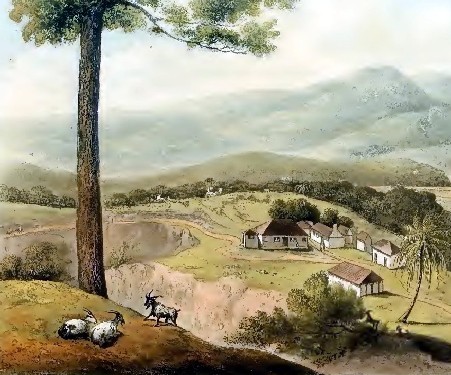
Artist: James Hakewill
Goats on Golden Vale Plantation, A Picturesque Tour of the Island of Jamaica (1825)
similarly, mentioned in that they are russet or spotted. "They are here not soe plentiful as other catel, neither are they much estemed, their fleash being not soe swet or fatt as our Europian mutton." 27 Blome notes that there are a lot of goats, "which thrive exceedingly well, the Countrey being very fit for them."28 Taylor says they are an African breed, being 'curiously spotted'. "Their flesh is most curious food; very gratful to the pallat, and of excelent nutriment."29
Several unusual land-based Jamaican animals are mentioned as food in the books under study. Taylor says "in the plantations there are aboundance of ratts, which live on the sugar canes... These are by many eaten, and accounted an excelent dish, and of which they make fricases and other quelquechoses [trifles]."30 Sloane notes that rats are "sold by the dozen, and when they have been bred amongst the Sugar-Canes, are thought by some discerning people very delicious Victuals."31 Taylor alone mentions wild dogs and cats as food, stating, "They are by maney eaten, and accounted excelent food."32 Taylor also talks about iguanas, although he doesn't say they are good as food. He does suggest they are found on the north side of Jamaica and in the small islands off shore, particularly Nevassa, which is between Jamaica and Cuba.33John Atkins mentioned that when HMS Weymouth was off Nevassa in August of 1722, the island was visited by Jamaicans in their boats in order "to kill Guanas, an amphibious Creature that breed in abundance at the Roots of old Trees... the Flesh [being] firm, white, and as Sailors say, makes good Broth."34
1 Richard Blome, A Description of the Island of Jamaica, 1672, p. 22; 2 Hans Sloane, A Voyage to the Islands Madera, Barbados, Nieves, St Christophers and Jamaica, Vol. 1, 1707, p. xvii; 3 Sloane, Vol. 1, p. xvi; 4 Sloane, Vol. 1, p. xvii; 5 John Taylor, Jamaica in 1687, David Buisseret ed, 2010, p. 133; 6 Charles Leslie, A New History of Jamaica in thirteen Letters, 1741, p. 24; 7 Taylor, p. 133; 8 Taylor, p. 86; 9 Sloane, Vol. 1, p. xvi; 10 Sloane, Vol. 2, p. 275; 11 Sloane, Vol. 1, p. xv; 12 Blome, p. 22-3 & Leslie, p. 24; 13 Sloane, Vol. 1, p. xvii; 14 Taylor, p. 133-4; 15 Sloane, Vol. 1, p. xvii; 16 Blome, p. 23; 17,18 Taylor, p. 134; 19 Sloane, Vol. 1, p. xvi; 20 Taylor, p. 135; 21 Sloane, Vol. 1, p. xvi; 22 Taylor, p. 135 & Sloane, Vol. 1, p. lxxvii; 23 Taylor, p. 135; 24 Blome, p. 23; 25 Leslie, p. 24; 26 Sloane, Vol. 2, p. 26; 27 Taylor, p. 133; 28 Blome, p. 23; 29 Taylor, p. 133; 30 Sloane, Vol. 1, p. xx; 32,33 Taylor, p. 136; 33 Taylor, p. 172; 34 John Atkins, A Voyage to Guinea and Brazil, 1735, p. 252
Fowl
Many types of fowl were mentioned as edible on Jamaica by the period authors. Among them are chickens, ducks, turkeys, pigeons, guinea fowl, "Plovers, Flemingos, Snipes,
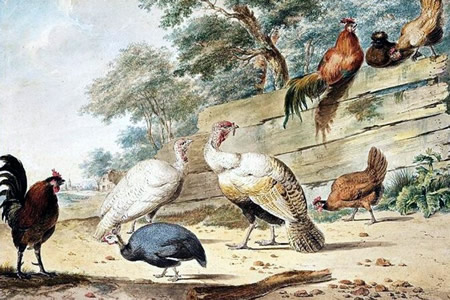
Artist: Christian Henning -
Chickens, Turkeys and a Guinea Fowl (late 17th - early 18th c.)
Parats, Parachetos [parakeets], with very many Others, whose names are not known."1 John Taylor discussed some edible birds not included in this list including the cloaching hen (probably a clucking hen or limpkin), turtle dove, osprey [which he calls a fish hawk], macaw and the frigate bird.2 He elsewhere says that in January and June "there is great plenty of wild fowle as duck, teal, widgeon, etc. found on this island of Jamaica, for hither then they resort in great plenty, and are sold in the markets at a reasonable rate."3 Hans Sloane mentions several fowl that were bred and raised on the Jamaican plantations in 'paleques' or enclosures made by driving wooden piles into the ground. Among them were "Turkeys... Hens, Ducks, Muscovy Ducks, and some very few Geese. ...These Poultry are all fed on Indian or Guinea Corn, and Ants Nests brought from the Woods, which these Fowls pick up and destroy mightily."4
As with other animals, Taylor has much to say about the various types of birds
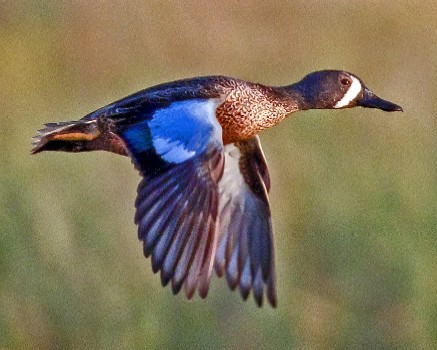
Photo: Dan Pancamo - Blue-winged Teal in Flight
found on Jamaica. He advises that turkeys there were 'verey large' and of the same sort as are found in Europe.5 Sloan concurs, explaining that the turkeys on the island "much exceed the European and are very good and well tasted"6. Both authors agree that duck were plentiful on Jamaica. Only one rates comment on its flavor: the teal (most likely the blue-winged teal - Spatula discors) which Sloane says "are very plentiful here, extremely fat, and very delicate Food."7
Jamaican Guinea hens found particular favor with both the authors who commented on them. Sloane says, "They are excellent Meat"8 while Taylor enthuses, "Their flesh is verey fatt, tender and of excelent nutriment, and are held of great esteme"9.
Taylor talks in some detail about the parrots he saw on Jamaica which his editor David Buisseret says are yellow-billed and black-billed parrots endemic to the island and Cuban and Puerto-Rican parrots which are migratory.10 Both Taylor and Sloane note that they taste like pigeons with Sloane adding that they were baked in pies.11
Taylor mentions several birds which Sloane doesn't discuss as food.
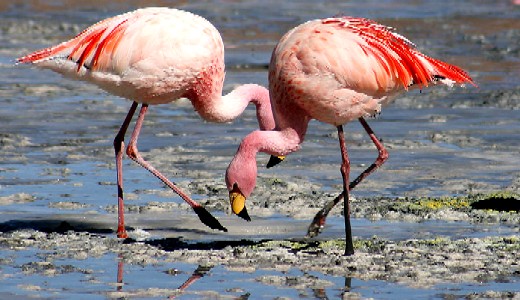
Photo: Valdiney Pimenta -
Flamingos in Bolivia
Among them are his 'cloaching' hen which he says is only on the island from September through March. "This bird is accounted a rarity being most delicat food and of excelent nutriment"12. Taylor talks about dining on an osprey and, while he doesn't say much about the flavor or value of the meat, his comment is entertaining in its way. "I once eat part of one of them roasted, on Cavalero Bay, and for my part, with it, and a good bowle of punch, I made a sufficient dinner therewith."13 He also states that macaws are "very good but they are seldom eaten, being kept tame as a curiousity."14 The last bird of interest were flamingos, which Taylor advises "are excelent food, full as good as an Europian turkie or bustard. Above all, his tung is counted as a great rarity being broyl'd, for it tasteth more delicate than marrow."15
1 Richard Blome, A Description of the Island of Jamaica, 1672, p. 24; 2 John Taylor, Jamaica in 1687, David Buisseret ed, 2010, pp. 140-4; 3 Taylor, p. 116; 4 Hans Sloane, A Voyage to the Islands Madera, Barbados, Nieves, St Christophers and Jamaica, Vol. 1, 1707, p. xvii; 5 Taylor, p. 139; 6 Sloane, Vol. 1, p. xvii; 7 Sloane, Vol. 2, p. 324; 8 Sloane, Vol. 2, p. 302; 9 Taylor, p. 140; 10 Taylor, pp. 141-2; 11 Taylor, p. 142 & Sloane, Vol. 2, p. 297; 12 Taylor, p. 139; 13 Taylor, p. 142; 14 Taylor, p. 143; 15 Taylor, p. 138
Imported Food
John Taylor mentions several items which were imported from the Colonies when he was there in 1687-8 including "provitions as beef,
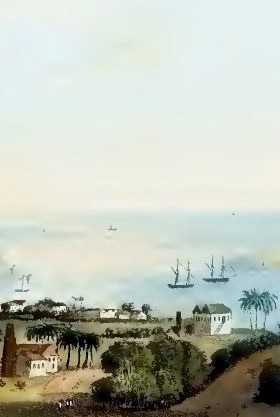
Artist: James Hakewill - Port Maria, Jamaica (1825)
pork, sturgeon, macerell, chees, butter, flower, and peass"1. The fish would have been dried and all of these things were the considered standard food items found on naval ships. Physician Hans Sloane also said there was trade in Jamaica with the Colonies "for Horses, Beef, Pork, Flower or Rusk [a type of biscuit], 'tis manag’d by Brigantines, or small Craft"2. Sloane elsewhere mentions biscuit (perhaps referring to rusk biscuit), pork, "Liquors of all sorts, &c"3. Sloane also notes that "Flour from New York is counted the best, but this as well as all other Flour, and Bisket, are subject to be spoil'd with Weevils, or small Scarabari, if long kept."4 In trade for these things, Jamaica supplied rum, molasses (which was made into rum in the colonies), sugar and logwood (used for dyes).5
Taylor says that ships coming from England brought a variety of imported goods, most of it cloth and items for use on ships such as tar, ropes and forged pieces, but he also mentions unspecified fruits and wine.6 According to Sloane, "Madera Wine is also imported in great quantities from the Island of that name, by Vessels sent from England on purpose, on all which the Merchant is supposed to Gain generally 50 per cent Profit."7 (The Madiera wine trade during this period is discussed here.) Sloane also counts flour, biscuit, beef and pork among the items sent from Europe. He says that Jamaica sends a wide variety of goods back to Europe including "Sugars, most part Muscavados, Indico, Cotton-wool, Ginger, Piemento All-Spice or Jamaica-Pepper, Fustick-wood [Maclura tinctoria], Prince-wood [Cordia alliodora], Lignum Vitae, Arnotto [annatto, a dye], Log-wood, and the several Commodities they have from the Spaniards of the West-Indies, (with whom they have a private Trade,) as Sarsaparilla, Cacao Nuts, Cochineel, &c. on which they get considerable Profit."8
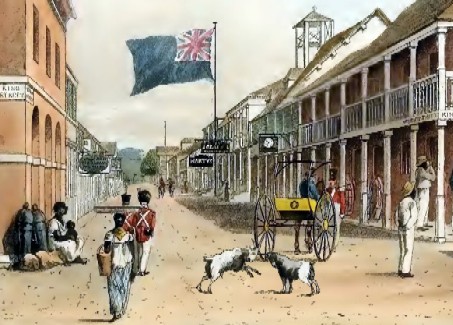
Artist: James Hakewill - Harbour Street, Kingston, Jamaica (1825)
Taylor says there is also bustling trade with Ireland, whose vessels bring in "great cargoes of Irish provision, as beef, pork, salmon, chees, butter, flower, beer, etc.; and those merchant trade here for the like commoditys."9 However, Charles Leslie suggests that the Irish beef was not a highly valued commodity on the island. "The Servants seldom are allowed any fresh Provisions, but feed on Irish salt Beef, which sometimes is exceeding coarse."10 The same was not true for provisions brought from Europe and the Colonies as has been explained.
It is interesting that the provisions most desired by the moneyed planters on Jamaica were the same foods which were being served to the sailors on their crossing the ocean. It also bears reiterating that most sailors staying on the island would have stayed around Port Royal and Kingston and would likely not have much experience outside of what was served to them while in port or at the taverns, inns and ordinaries on the island.
1 John Taylor, Jamaica in 1687, David Buisseret ed, 2010, p. 241; 2 Hans Sloane, A Voyage to the Islands Madera, Barbados, Nieves, St Christophers and Jamaica, Vol. 1, 1707, p. lvi; 3 Sloane, Vol. 1, p. lv; 4 Sloane, Vol. 1, p. xix; 5 Sloane, Vol. 1, p. lv & Taylor, p. 241; 6 Taylor, p. 241; 7,8 Sloane, Vol. 1, p. lv; 9 Taylor, p. 241; 10 Charles Leslie, A New History of Jamaica in thirteen Letters, 1741, p. 24

